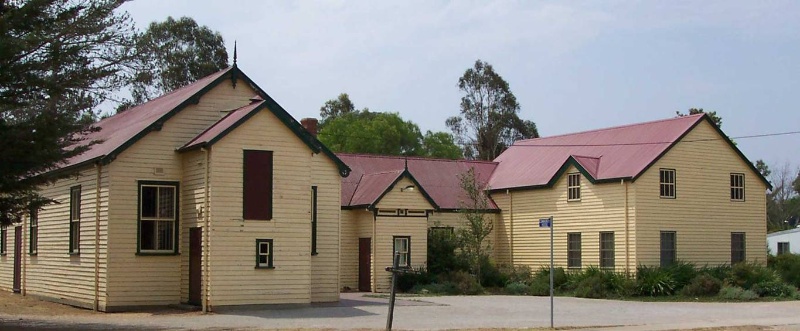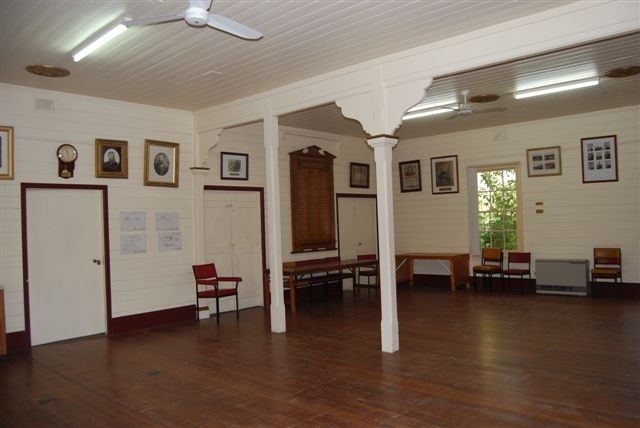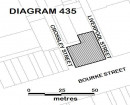MECHANICS INSTITUTE AND COLLECTION
9-11 AVON STREET BRIAGOLONG, WELLINGTON SHIRE
-
Add to tour
You must log in to do that.
-
Share
-
Shortlist place
You must log in to do that.
- Download report





Statement of Significance
What is significant?
In March 1874 the first building of the Briagolong Mechanics Institute was officially opened; a red gum weatherboard building with a shingle roof. Although there is no known architect, the builder is recorded as Robert Vick of Stratford. The first building consisted of the back portion of the supper room, the ladies' room and the entry corridor. Briagolong Mechanics Institute was built in a number of stages between 1874 and 1930; further additions were made in the late twentieth century. In 1879 the original reading room and the old kitchen were built, and in 1887 the first section of the main hall and the stage was added. In 1890 the hall was extended and in 1902 the 'smoking' room was added as well as the supper room extension. A larger, more decorative porch was also added at this time. In 1907 the billiard room (the current library) was added. The only other significant addition was in c. 1930 when the bio box was added to the main hall for the screening of motion pictures.
The development and preservation of Briagolong Mechanics Institute over a long period of time reflects its ongoing use and the important role it played in the community. Since its inception Briagolong Mechanics Institute has been a place of meeting for community service groups, a venue for entertainment, for community fundraising in the forms of concerts, festivals, balls and other social gatherings involving sports such as quoits, billiards, draughts, chess, and educational classes such as music, drawing and dancing lessons and for the screening of motion pictures.
The Briagolong Mechanics Institute collection, housed in the building, comprises a library collection and a collection of archives and heritage objects that were used and displayed in association with the building's use as a Mechanics Institute. The library collection is composed of nineteenth and early twentieth century books most of which are fiction. The library collection is catalogued and the catalogue has been integrated into the Wellington Shire Council's Library service. This catalogue lists 1380 entries, some of which are for multiple volumes; around 75% of the collection is fiction and around 40% of the collection was published in the nineteenth century.
The general collection includes an early twentieth century Australian made Wertheim piano decoratively carved with an ornate Australiana floral motif which was purchased in 1913 and has been in continuous use since then. The collection includes a stereographic photograph collection dating from 1913 and stereoscopic viewer (date unknown); these stereographic photographs were purchased as a collection and were taken by A.J. Waugh (1868-1928) an amateur photographer from Maffra. Other notable collection items include two framed illuminated addresses to local community members (dated 1893, 1906 respectively), the 'Rules and Regulations' banner for the Mechanics Institute dating from the c.1920s, a cast iron fountain or urn recently located within the building believed to be the original fountain kettle used in the 1874 kitchen fireplace, two illuminated addresses, framed photographs and plaques, the World War I honour roll, furniture (stools, long seats, tables), and two hand painted stage backdrops dating from c.1907 and c.1934.
How is it significant?
Briagolong Mechanics Institute and its collection are of architectural, historical and social significance to the State of Victoria.
Why is it significant?
The Briagolong Mechanics Institute and its collection have historical and social significance for their association with the Mechanics Institute movement and the important role this movement played in the social, cultural, and intellectual development of Victorians from the latter part of the nineteenth century right through the twentieth century to the present.
The Briagolong Mechanics Institute is architecturally significant as a representative example of a Mechanics Institute in a small country town. The architectural design is distinctive yet simple and uses materials which were locally sourced. Although the building has been expanded and adapted, the original buildings remain intact and to a large extent, unchanged. In tracing the development of the institute over time, one can trace the development and growth of a Victorian town and how its Mechanics Institute was adapted and extended to meet the needs of the community over a long period of time.
The Briagolong Mechanics Institute library collection is of historical and social significance as a rare example of a preserved Mechanics Institute library which reflects the tastes and interests of a Victorian country community from 1874 until the early 1960s. The library, together with the associated general collection of objects, is representative of the type of collection which would have been found at Mechanics Institutes throughout Victoria from the mid nineteenth century onwards. The collection reflects the community uses of the place over time and emphasises the central place that the Mechanics Institute held in the community.
-
-
MECHANICS INSTITUTE AND COLLECTION - Plaque Citation
This hall has been in continuous use since 1874 and is significant for its rare and intact library. Built in several stages from 1874 the Institute expanded to meet changed community requirements.
MECHANICS INSTITUTE AND COLLECTION - Permit Exemptions
General Exemptions:General exemptions apply to all places and objects included in the Victorian Heritage Register (VHR). General exemptions have been designed to allow everyday activities, maintenance and changes to your property, which don’t harm its cultural heritage significance, to proceed without the need to obtain approvals under the Heritage Act 2017.Places of worship: In some circumstances, you can alter a place of worship to accommodate religious practices without a permit, but you must notify the Executive Director of Heritage Victoria before you start the works or activities at least 20 business days before the works or activities are to commence.Subdivision/consolidation: Permit exemptions exist for some subdivisions and consolidations. If the subdivision or consolidation is in accordance with a planning permit granted under Part 4 of the Planning and Environment Act 1987 and the application for the planning permit was referred to the Executive Director of Heritage Victoria as a determining referral authority, a permit is not required.Specific exemptions may also apply to your registered place or object. If applicable, these are listed below. Specific exemptions are tailored to the conservation and management needs of an individual registered place or object and set out works and activities that are exempt from the requirements of a permit. Specific exemptions prevail if they conflict with general exemptions. Find out more about heritage permit exemptions here.Specific Exemptions:General Conditions: 1. All exempted alterations are to be planned and carried out in a manner which prevents damage to the fabric of the registered place or object. General Conditions: 3. If there is a conservation policy and plan endorsed by the Executive Director, all works shall be in accordance with it. Note: The existence of a Conservation Management Plan or a Heritage Action Plan endorsed by the Executive Director, Heritage Victoria provides guidance for the management of the heritage values associated with the site. It may not be necessary to obtain a heritage permit for certain works specified in the management plan. General Conditions: 4. Nothing in this determination prevents the Executive Director from amending or rescinding all or any of the permit exemptions. General Conditions: 5. Nothing in this determination exempts owners or their agents from the responsibility to seek relevant planning or building permits from the responsible authorities where applicable. Minor Works : Note: Any Minor Works that in the opinion of the Executive Director will not adversely affect the heritage significance of the place may be exempt from the permit requirements of the Heritage Act. A person proposing to undertake minor works may submit a proposal to the Executive Director. If the Executive Director is satisfied that the proposed works will not adversely affect the heritage values of the site, the applicant may be exempted from the requirement to obtain a heritage permit. If an applicant is uncertain whether a heritage permit is required, it is recommended that the permits co-ordinator be contacted.Registered Building
Briagolong Community House: All works, including internal modifications.
Exterior:
Removal of extraneous items such as air conditioners, pipe work, ducting, wiring, antennae, aerials etc, and making good.
Installation and repairing of damp proofing by either injection method or grout pocket method.
Installation or removal of external fixtures and fittings such as, hot water services and taps.
Interior:
Painting of previously painted walls and ceilings provided that preparation or painting does not remove evidence of any original paint or other decorative scheme.
Installation, removal or replacement of carpets and/or flexible floor coverings.
Installation, removal or replacement of curtain tracks, rods and blinds.
Installation, removal or replacement of hooks, nails and other devices for the hanging of mirrors, paintings and other wall mounted art or religious works or icons.
Demolition or removal of non-original stud/partition walls, suspended ceilings or non-original wall linings (including plasterboard, laminate and Masonite), bathroom partitions and tiling, sanitary fixtures and fittings, kitchen wall tiling and equipment, lights, built-in cupboards, cubicle partitions, computer and office fitout and the like.
Removal or replacement of non-original door and window furniture including, hinges, locks, knobsets and sash lifts.
Installation of stud walls, which are removable.
Refurbishment of existing bathrooms, toilets and kitchens including removal, installation or replacement of sanitary fixtures and associated piping, mirrors, wall and floor coverings.
Removal of tiling or concrete slabs in wet areas provided there is no damage to or alteration of original structure or fabric.
Installation, removal or replacement of ducted, hydronic or concealed radiant type heating provided that the installation does not damage existing skirtings and architraves and that the central plant is concealed.
Installation, removal or replacement of electrical wiring.
Installation, removal or replacement of electric clocks, public address systems, detectors, alarms, emergency lights, exit signs, luminaires and the like on plaster surfaces.
Installation, removal or replacement of bulk insulation in the roof space.
Installation of plant within the roof space.
Installation of new fire hydrant services including sprinklers, fire doors and elements affixed to plaster surfaces.
Registered Collection
Referring to the permit policy above; until a Collection Management Policy or Plan has been implemented (which may be incorporated within an overall Conservation Management Plan) the relocation, loan or conservation of any part of the collection is subject to a permit application.
MECHANICS INSTITUTE AND COLLECTION - Permit Exemption Policy
The cultural heritage significance of Briagolong Mechanics Institute is due to its historical, social and architectural associations. The original plan form is relatively intact and many early features survive throughout. This exemptions policy recognises that some alterations have occurred and that further upgrading of service spaces will take place in the future. The purpose of the permit exemptions is to allow works that do not impact on the heritage significance of the place to occur without the need for a permit. Alterations which impact on the significance of this structure are subject to permit applications.
All works to the1999 building known as the Briagolong Community House, including internal modification, are permit exempt, but any further additions or demolitions would require permits. Permits would be required for any new buildings and structures on the registered land.
The preparation of a Conservation Management Policy and Plan is encouraged. Permit exemptions for the collection may be granted after a Conservation Management Policy and Plan has been implemented. Until such time, relocation, loan and conservation of any of the collection items would be subject to permit applications.
-
-
-
-
-
Clovelly
 National Trust
National Trust -
Mechanics Institute
 National Trust H0550
National Trust H0550 -
Briagolong War Memorial
 Vic. War Heritage Inventory
Vic. War Heritage Inventory
-
'Boonderoo', House and Outbuildings
 Greater Bendigo City
Greater Bendigo City -
'Riverslea' house
 Greater Bendigo City
Greater Bendigo City -
1 Adam Street
 Yarra City
Yarra City
-
-












